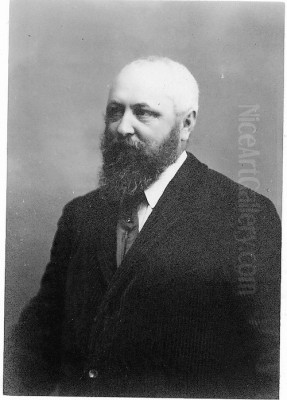
Theodore Earl Butler stands as a significant yet often subtly acknowledged figure in the narrative of American Impressionism. Bridging the artistic worlds of the United States and France, his life and work were deeply intertwined with the epicenter of Impressionism, Giverny, and its most famous resident, Claude Monet. Butler's journey from Columbus, Ohio, to the heart of the French art scene, his familial connection to Monet, and his distinct artistic voice offer a fascinating study in transatlantic cultural exchange and artistic development. His work captures the ephemeral qualities of light and atmosphere, applied to both the gentle landscapes of Normandy and the bustling energy of New York City.
Early Life and Artistic Formation
Born on December 10, 1861, in Columbus, Ohio, Theodore Earl Butler was the son of Courtland Philip Livingston Butler and Elizabeth Pierce. His early education led him to Marietta College. However, his artistic inclinations soon guided him towards formal training. In 1882, seeking a robust artistic education, Butler enrolled at the Art Students League of New York, a pivotal institution known for fostering progressive artistic talent in America.
At the League, Butler studied under influential figures who were shaping American art. Among his instructors were William Merritt Chase, a leading American Impressionist and charismatic teacher known for his bravura brushwork, and J. Carroll Beckwith, another prominent figure painter and instructor who emphasized academic rigor combined with modern sensibilities. The training received here provided Butler with a strong foundation in drawing and painting, exposing him to the latest artistic currents circulating between Europe and America. This period was crucial in honing his technical skills and shaping his early artistic outlook before his pivotal move abroad.
Journey to Paris and Early Recognition
Like many ambitious American artists of his generation, Butler felt the pull of Paris, then the undisputed capital of the art world. He traveled to France in 1888, seeking advanced training and immersion in the European avant-garde. Paris offered unparalleled opportunities to study Old Masters, engage with contemporary art movements, and exhibit work on an international stage. Butler likely attended one of the popular independent ateliers, such as the Académie Julian or Académie Colarossi, favored by foreign students.
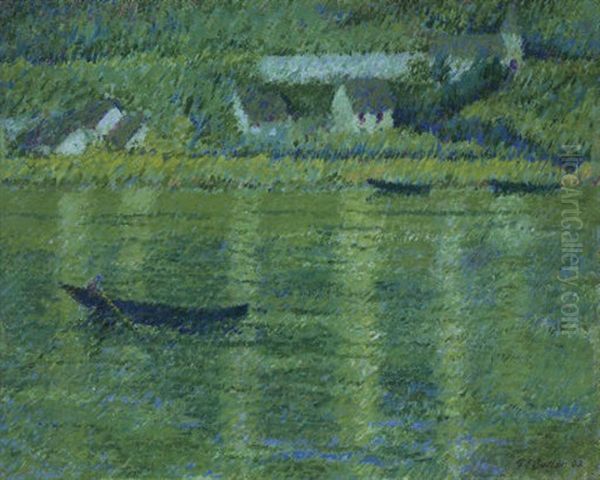
His time in Paris quickly yielded results. Butler submitted his work to the prestigious Paris Salon, the official art exhibition of the Académie des Beaux-Arts. In 1888, his painting "La Veuve" (The Widow) was accepted and awarded an honorable mention. This recognition was a significant achievement for a young foreign artist, signaling his arrival on the competitive Parisian art scene and validating his decision to pursue his career in France. This early success bolstered his confidence and set the stage for his deeper engagement with French Impressionism.
Giverny and the Monet Connection
Butler's path soon led him to Giverny, a small village in Normandy that had become an artistic colony centered around the towering figure of Claude Monet, who had settled there in 1883. Drawn by the picturesque landscape and the presence of the Impressionist master, numerous artists, particularly Americans, flocked to the area. Butler became part of this vibrant community, finding inspiration in the rural scenery and the camaraderie of fellow painters.
It was in Giverny that Butler formed the most defining relationship of his personal and artistic life. He grew close to the Monet household. Initially, Monet was reportedly somewhat reserved about the influx of artists, but Butler's charm and talent eventually won him over. This connection was cemented when Butler fell in love with Monet's stepdaughter, Suzanne Hoschedé. Suzanne was the daughter of Alice Hoschedé and Ernest Hoschedé, a collector and early patron of Monet; Alice later became Monet's second wife after Ernest's death and the death of Monet's first wife, Camille Doncieux.
Marriage, Family, and Domestic Themes
Theodore Butler and Suzanne Hoschedé were married on July 20, 1892, in a civil ceremony in Giverny. The event was a significant moment within the Giverny circle, famously captured in a painting by Monet himself, depicting the wedding procession. Monet, initially perhaps hesitant about the union, served as a witness. This marriage formally brought Butler into the Monet family circle, deepening his relationship with the master Impressionist.
Butler and Suzanne had two children, James Butler and Lili Butler. Family life became a central theme in Butler's art during this period. He painted numerous intimate scenes featuring Suzanne and their children in their home and garden in Giverny, capturing tender moments with the characteristic light and color of Impressionism. These works possess a warmth and personal quality that distinguishes them. Tragically, Suzanne Hoschedé died relatively young in 1899. A year later, in 1900, Butler married Suzanne's older sister, Marthe Hoschedé, further solidifying his ties to the Monet family. Marthe also frequently appeared in his paintings.
Artistic Style: Impressionism and Beyond
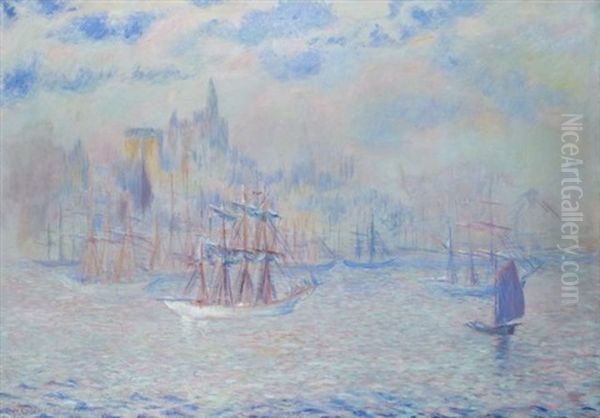
Theodore Earl Butler is firmly categorized as an American Impressionist, yet his style evolved and retained a distinct individuality throughout his career. Living and working in Giverny placed him in direct dialogue with Claude Monet, and Monet's influence is undeniable, particularly in Butler's sensitivity to light, his use of color to capture atmospheric effects, and his broken brushwork. Butler adopted the Impressionist practice of painting en plein air (outdoors) to directly observe the changing conditions of light and weather.
However, Butler was not merely a follower. While absorbing lessons from Monet, particularly regarding the palette, he maintained an independent artistic direction often described as bolder or more structured than some of his Giverny contemporaries. His compositions often feature strong diagonal lines and a dynamic sense of arrangement. His subjects frequently included intimate family scenes, differentiating his focus somewhat from Monet's purer landscape and serial works.
Later in his career, particularly during his time in New York and after, Butler's work showed tendencies associated with Post-Impressionism. He employed even more vibrant, sometimes non-naturalistic colors, and his brushwork could become more expressive and textured, occasionally incorporating elements reminiscent of Pointillism or Fauvism in its energy. He adeptly balanced the Impressionist concern for fleeting moments with a Post-Impressionist interest in structure and emotional expression. His palette often featured blues, grays, purples, and light greens, skillfully used to render effects like fog, sunlight on water, or the dappled light of a garden.
Representative Works: Giverny and New York
Butler's oeuvre includes several key works that highlight his stylistic range and thematic interests. "La Veuve" (1888), his early Salon success, demonstrated his academic training combined with modern sensibilities. "The Wedding March" (c. 1892), depicting his own wedding procession with Suzanne Hoschedé, is a quintessential Giverny painting, capturing a personal event with Impressionist light and color, and notably features figures like Claude Monet in the background.
His paintings of family life, such as those featuring Suzanne, Marthe, James, and Lili in the garden or house at Giverny, are among his most charming and personal works. They showcase his ability to blend figure painting with landscape elements in an Impressionist style. "The Seine at Port-Villez" (early 1900s) represents his engagement with the classic Normandy landscape, rendered with attention to water reflections and atmospheric conditions, echoing Monet's interests but with Butler's own touch.
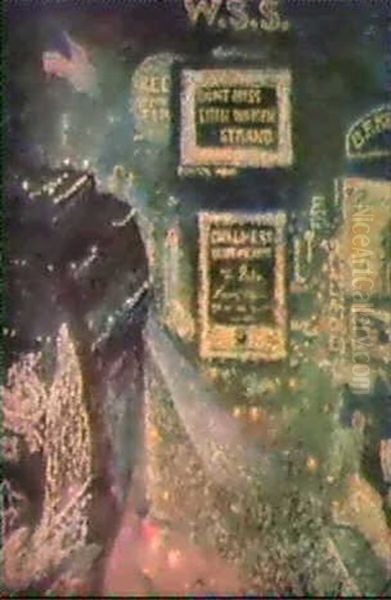
During his time in the United States, Butler tackled different subjects. "Ships in New York Harbor" (1907) uses a characteristic palette of blues, grays, and purples to capture the hazy, light-filled atmosphere of the busy port. "Brooklyn Bridge" (c. 1916-1918) shows his application of Impressionist techniques to the iconic urban structure. Perhaps his most dynamic American work is "Armistice Day" (1918), a vibrant depiction of the celebrations on Fifth Avenue marking the end of World War I. Using broken color, energetic brushstrokes, and a high viewpoint, he captured the excitement and movement of the crowd and flags, demonstrating a move towards a more expressive, almost Fauvist energy. "All Together" was another patriotic work related to the war effort.
The American Interlude: World War I
The outbreak of World War I in 1914 significantly disrupted Butler's life in France. As American citizens, Butler and his family found it necessary to return to the United States. They remained in New York from roughly 1914/1915 until 1921. This period, though enforced, proved artistically productive and saw Butler engage actively with the American art scene.
He had already established some presence in the US, exhibiting two works, "Marine" and "Fourteenth and July," at the groundbreaking Armory Show in New York City in 1913. This exhibition famously introduced European modernism on a large scale to American audiences. During his wartime stay, Butler painted numerous scenes of New York City, capturing its bridges, harbors, and street life with his Impressionist and evolving Post-Impressionist style. He was one of the earliest artists to depict New York State landscapes using Impressionist techniques.
Furthermore, Butler became involved in organizing activities within the New York art world. Alongside his friend, the Ashcan School painter John Sloan, and other progressive artists like Arthur B. Davies and Walt Kuhn (key organizers of the Armory Show), Butler helped found the Society of Independent Artists in 1916. Modeled after the French Société des Artistes Indépendants, the SIA championed the principle of "no jury, no prizes," aiming to provide an open venue for all artists to exhibit their work. Butler served on the SIA's board of directors from 1918 to 1921. He also contributed to the war effort through his art and activities, working with the American Red Cross and creating works like "All Together" to support fundraising, often in collaboration with his wife, Marthe.
Return to Giverny and Later Years
With the conclusion of World War I and the stabilization of conditions in Europe, Theodore Earl Butler and his family returned to their home in Giverny in 1921. He resumed his life in the familiar artistic milieu, surrounded by the landscapes and gardens that had long inspired him. He continued to paint actively, exploring the nuances of light and color in the Normandy countryside.
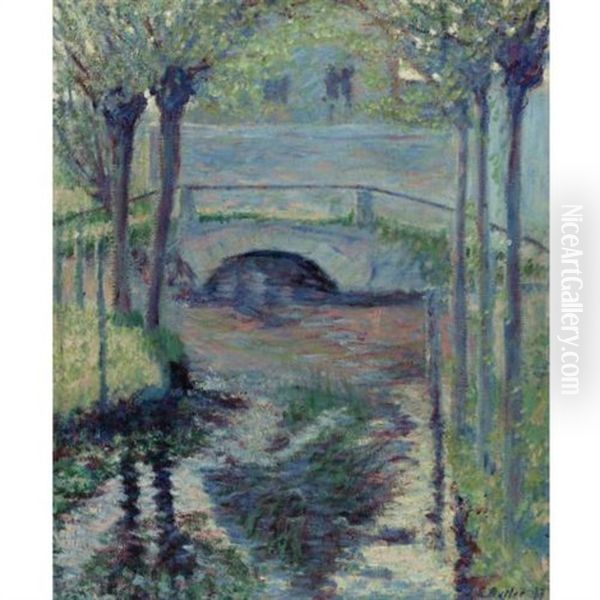
Butler maintained his connections with the Parisian art world, regularly exhibiting his work at the Salon d'Automne, an important annual exhibition established in 1903 as an alternative to the more conservative official Salon, often showcasing more progressive and avant-garde art. His participation indicates his continued relevance and engagement with contemporary French art circles even in his later years.
He spent the remainder of his life in Giverny, deeply rooted in the community he had first joined decades earlier. Theodore Earl Butler passed away in Giverny on May 2, 1936, at the age of 74. He is buried in the Giverny church cemetery, close to members of the Monet family, a final testament to the profound connection that shaped much of his life and art.
Relationships with Contemporaries
Butler's artistic journey was enriched by his interactions with numerous other artists. The most significant relationship was undoubtedly with Claude Monet, his father-in-law. This connection provided Butler with unparalleled access to the master Impressionist, leading to both influence and friendship, though it also perhaps contributed to Butler being somewhat overshadowed.
In Giverny, Butler was part of a thriving international art colony. He was introduced to Monet, according to some accounts, by fellow American Impressionist Theodore Robinson, who was also a close confidant of Monet and a key figure in the Giverny circle before his early death in 1896. Butler would have known and worked alongside other prominent American Impressionists who spent time in Giverny, such as Willard Metcalf, Louis Ritter, John Leslie Breck, and Lilla Cabot Perry, who also forged a close relationship with Monet.
Back in the United States, his teachers William Merritt Chase and J. Carroll Beckwith were major figures in the American art establishment. His collaboration with John Sloan in founding the Society of Independent Artists connected him with the more gritty, urban realism of the Ashcan School, even though their styles differed. Other American Impressionists whose careers paralleled Butler's in some ways include Childe Hassam, J. Alden Weir, and John Henry Twachtman, who together formed the core of the group known as "The Ten American Painters." Philip Leslie Hale was another American artist active in France around the same time. While perhaps not collaborating directly on canvases often, these artists shared exhibition venues, artistic concerns, and the experience of adapting European Impressionism to an American context. Butler's unique position was his deep integration into the French Impressionist heartland through his family ties.
Legacy and Historical Assessment
Theodore Earl Butler occupies a unique niche in art history. As an American deeply embedded in the French Impressionist movement through his Giverny residency and marriage into the Monet family, he served as a living bridge between the art worlds of France and the United States. His work embodies the successful adaptation of Impressionist principles to both French and American subjects.
While his talent was recognized by his peers, Butler's historical reputation was for a long time somewhat muted, often discussed primarily in relation to his famous father-in-law. Monet's towering presence inevitably cast a long shadow. However, in recent decades, art historians and curators have increasingly recognized Butler's individual contributions and the quality of his work. His paintings are appreciated for their vibrant color, sensitivity to light, intimate portrayal of family life, and his ability to capture the essence of place, whether it be the gardens of Giverny or the dynamic streets of New York.
He is seen as a key figure among the second wave of American artists drawn to Giverny, distinct from the earlier generation like Robinson. His exploration of techniques bordering on Post-Impressionism in his later work also marks him as an artist who continued to evolve. His role in founding the Society of Independent Artists highlights his commitment to progressive artistic causes in America. Today, his works are held in numerous museum collections, and he is acknowledged as an important American Impressionist painter in his own right.
Conclusion
Theodore Earl Butler's life story is one of artistic dedication played out across two continents. From his foundational training in New York to his immersion in the Impressionist circle of Giverny and his active participation in the American art scene, Butler forged a distinct path. His close relationship with Claude Monet and his family provided him with a unique vantage point, enriching his life and art, while his own talent ensured his contribution was original. His paintings, characterized by luminous color, sensitive observation, and a blend of Impressionist and Post-Impressionist techniques, capture intimate moments and evocative landscapes, securing his place as a significant and engaging figure in the history of American art.